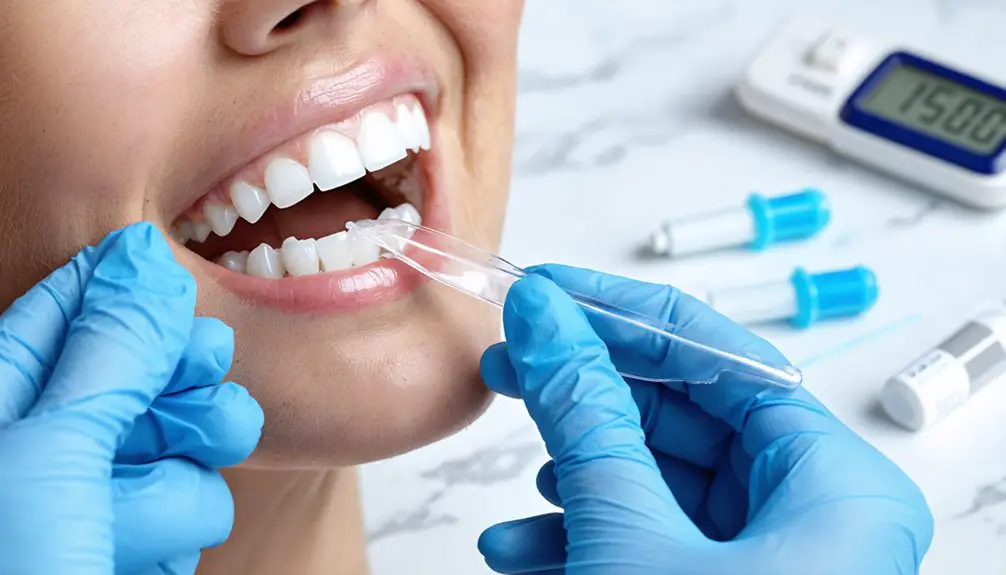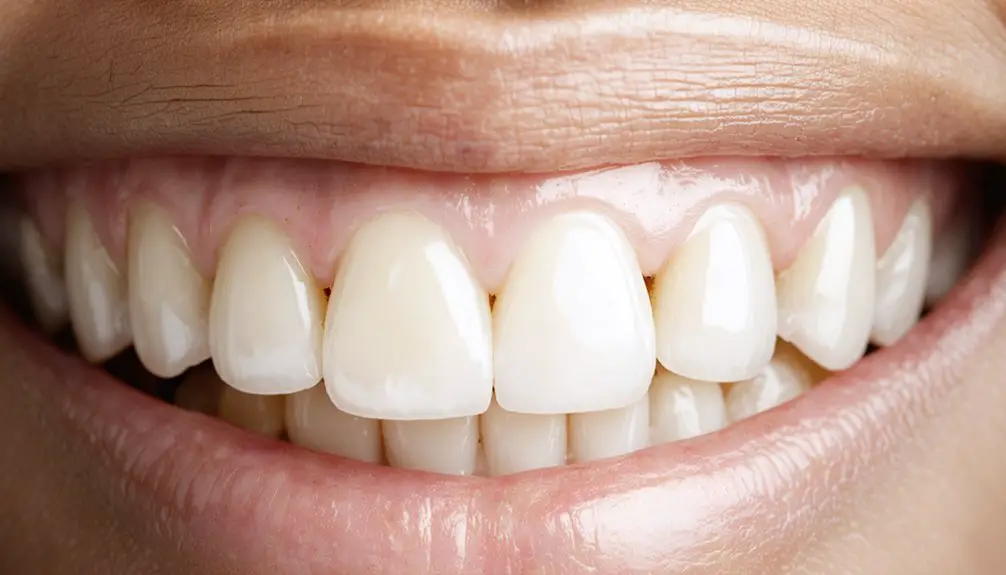You’ll need a professional consultation before starting any teeth whitening treatment to assess your oral health and determine the safest approach. Always choose ADA-approved products and follow manufacturer instructions carefully to protect your enamel and gums. Take breaks between treatments, use sensitivity toothpaste, and monitor for adverse reactions like persistent tooth pain or gum irritation. Understanding proper precautions and timing will help you achieve the best whitening results while maintaining your dental health.
Key Takeaways
- Schedule a consultation with a qualified dentist for a personalized treatment plan and proper assessment of oral health.
- Choose products with ADA Seal of Acceptance to ensure safety and efficacy of whitening treatments.
- Follow manufacturer instructions precisely, including recommended application times and frequency of treatments.
- Use desensitizing toothpaste before whitening and take breaks between sessions to prevent tooth sensitivity.
- Monitor for warning signs like persistent sensitivity or gum irritation, and consult a dentist if problems develop.
Professional Consultation: Your First Step to Safe Whitening
Before beginning any teeth whitening treatment, scheduling a professional consultation with a qualified dentist is essential to confirm both safety and ideal results.
During your consultation, your dentist will conduct a thorough oral examination to assess your teeth and gum health, identifying any concerns that could affect treatment outcomes. This detailed evaluation reveals potential complications from cavities, worn enamel, or gum disease that must be addressed first.
The consultation benefits extend beyond basic screening, as your dentist will review your dental history and discuss patient expectations to create a customized treatment approach. Dentists can select the proper concentration level based on your unique staining patterns and sensitivity.
You’ll receive expert guidance on whether professional whitening is appropriate for your situation, especially important if you’re pregnant, nursing, or have existing dental sensitivities. Your dentist will design a personalized care plan to prevent any potential damage to your teeth or gums.
This initial assessment confirms you’ll receive the safest, most effective whitening solution for your specific needs.
Understanding ADA-Approved Products and Their Benefits
When selecting teeth whitening products, understanding the American Dental Association (ADA) Seal of Acceptance provides essential guidance for safety and efficacy.
Products earning this seal meet rigorous ADA standards through extensive clinical trials and safety assessments.
You’ll find ADA-approved options like Crest 3D Whitestrips and specific whitening toothpastes that have demonstrated proven whitening effectiveness.
These products contain regulated amounts of active ingredients like hydrogen peroxide or gentle abrasives that safely remove stains without damaging enamel.
Results can last six months or longer when used as directed.
The Mason Business Center in Ohio serves as the headquarters where these products are developed and tested.
The rigorous evaluation process requires manufacturers to submit product information and research to the ADA Council on Scientific Affairs.
Essential Safety Guidelines for At-Home Whitening
Before using any teeth whitening product, you’ll need to verify it carries ADA approval by checking for the organization’s seal of acceptance on the packaging.
You must follow the manufacturer’s instructions precisely regarding application time, frequency, and proper technique to prevent enamel damage and gum irritation. Carefully rinse your mouth after each treatment to ensure all bleaching agents are removed.
Watch carefully for signs of tooth sensitivity or soft tissue reactions during treatment, and stop use immediately if you experience any adverse effects. Consider consulting with your dental professional first to assess your oral health and determine the most suitable whitening method for your specific needs.
Check Product Certifications First
Since teeth whitening products can vary greatly in quality and safety, checking proper certifications is an essential first step before beginning any at-home treatment.
When examining product labels, look for recognized certifications that validate ingredient transparency and manufacturing standards. FDA certified manufacturers consistently maintain complaint rates below 1%.
Products awarded certifications undergo extensive scientific review by qualified experts to validate safety claims before approval.
Key certifications to verify:
- ADA Seal of Acceptance – confirms thorough testing by dental experts and meets rigorous safety standards
- CE certification – validates compliance with European Union safety requirements
- GMP certification – guarantees manufacturing in hygienic facilities with >98% qualification rates
- ISO9001 certification – demonstrates adherence to globally recognized quality management systems
Don’t trust products lacking these important certifications, as they may not have undergone proper testing or could contain unsafe ingredients.
Your safety depends on choosing products that meet established quality and regulatory standards.
Monitor for Adverse Effects
While teeth whitening treatments can effectively brighten your smile, monitoring for adverse effects remains essential throughout the process. Pay close attention to tooth sensitivity, which can range from mild discomfort to sharp pain when exposed to temperature changes or sweet foods. Track any symptom patterns to help identify triggers.
Watch for signs of gum irritation, including redness, swelling, or burning sensations. If you notice whitened or inflamed areas on your gums, stop treatment immediately as these indicate potential chemical burns. The oxygen molecules in peroxide-based agents penetrate tooth enamel to break down stains.
Monitor for adverse reactions like excessive inflammation, particularly if you experience electric shock-like sensations during treatment. Using desensitizing gels can help minimize discomfort during the whitening process. Record the timing and location of any discomfort to share with your dental professional.
For persistent symptoms or severe sensitivity, consult your dentist for personalized adjustments to your whitening protocol.
Follow Instructions Precisely
Following proper instructions stands as the cornerstone of safe at-home teeth whitening treatments.
You’ll need to carefully review all product documentation and follow application techniques precisely to guarantee peak results while protecting your dental health.
- Always read the complete instruction manual before starting treatment, paying special attention to recommended product quantities and exposure times.
- Apply whitening gel only to tooth surfaces, avoiding contact with gums and soft tissues.
- Don’t exceed the specified treatment duration – most sessions should last between 30-60 minutes.
- Rinse thoroughly after each use and wait the recommended time between treatments.
Managing Tooth Sensitivity During Treatment

You’ll want to begin using desensitizing toothpaste or gels at least two weeks before starting your whitening treatment to reduce potential discomfort.
Taking breaks between whitening sessions allows your teeth to recover and helps prevent heightened sensitivity from prolonged exposure to bleaching agents.
If you experience persistent sensitivity, you can extend the time between treatments from daily to every other day while still achieving your desired results.
Desensitizing Products Before Whitening
Before starting any teeth whitening treatment, using appropriate desensitizing products can greatly reduce discomfort and improve your overall experience.
Desensitizing agents work by either blocking nerve signals or sealing dentinal tubules, while maintaining whitening efficacy. You’ll find several proven options to protect your teeth:
- Apply fluorine neutral 2% gel before treatment to physically block sensitive areas.
- Use potassium nitrate 5% with sodium fluoride 2% to reduce nerve sensitivity.
- Brush with specialized desensitizing toothpaste twice daily before and during treatment.
- Consider high-fluoride toothpaste (5000 ppm) if you have pre-existing sensitivity.
For ideal results, combine these methods under professional supervision, especially when using higher peroxide concentrations.
Lower-concentration whitening gels with built-in desensitizers offer excellent protection while still delivering desired results.
Break Schedule Between Sessions
When undergoing teeth whitening treatments, maintaining proper intervals between sessions is essential for protecting your enamel and managing sensitivity.
For professional treatments, you’ll need to wait 6 to 12 months between sessions, while at-home kits require breaks of 2 to 4 weeks for ideal sensitivity management.
To minimize discomfort, apply whitening gels every other day instead of daily. If you’re using high-concentration in-office treatments, the break duration must be longer due to their stronger bleaching agents.
Watch for prolonged sensitivity or gum irritation, as these signs indicate you need extended breaks. During rest periods, use fluoride treatments to strengthen your enamel and reduce sensitivity.
Maintaining Optimal Oral Health While Whitening
Maintaining ideal oral health during teeth whitening requires a balanced approach between achieving desired results and protecting dental structures.
You’ll need to adjust your daily oral care routine to support both whitening efficacy and dental protection.
- Choose a suitable toothpaste designed for sensitivity and use a soft-bristled brush to prevent enamel wear while whitening.
- Floss diligently after treatments to remove any residual whitening agents and prevent gum irritation.
- Avoid using mouthwash simultaneously with whitening products, as this can reduce effectiveness and increase sensitivity.
- Focus on whitening-friendly foods that naturally clean teeth while avoiding staining substances.
Remember to monitor any tooth sensitivity or gum changes during treatment.
If you experience persistent discomfort, pause your whitening regimen and consult your dentist for personalized guidance.
Common Risk Factors and Warning Signs

Understanding the risks associated with teeth whitening is essential for safe and effective treatment outcomes. You’ll need to watch for warning signs like persistent tooth sensitivity, gum blistering, or prolonged soft tissue irritation that lasts beyond a few days. These symptoms may indicate improper product use or potential damage requiring professional evaluation.
Several risk factors can amplify adverse effects. If you have pre-existing enamel erosion or dental sensitivity, you’re more susceptible to negative reactions. High-concentration peroxide products, especially those above 33%, can cause serious complications including nerve damage and gum recession.
Children and teenagers face greater risks of sensitivity and enamel damage, requiring careful assessment before treatment. Be particularly cautious with DIY or unregulated products, as their inconsistent ingredients pose higher safety risks.
Creating a Sustainable Whitening Schedule
A sustainable teeth whitening schedule requires careful planning to balance effectiveness with safety.
Your whitening frequency should align with the treatment method while allowing adequate enamel recovery time between sessions.
Follow these essential guidelines to protect your teeth:
- Space professional whitening treatments 6-12 months apart to prevent enamel damage.
- Use at-home whitening kits every 2-4 weeks, following product instructions precisely.
- Limit natural whitening methods like baking soda to once weekly.
- Maintain results with daily whitening toothpaste between major treatments.
Track any sensitivity during your whitening routine and adjust your schedule accordingly.
If you experience persistent discomfort, consult your dentist to modify your approach.
Remember to coordinate whitening treatments with your regular dental cleanings for peak oral health maintenance.
Frequently Asked Questions
Can Teeth Whitening Affect Existing Dental Fillings or Bonding Materials?
Your fillings won’t lighten with whitening treatments, risking visible discoloration against bleached natural teeth. The process can also temporarily affect bonding integrity, so consult your dentist before proceeding.
How Long Should I Wait After Teeth Cleaning Before Starting Whitening Treatments?
Just as a freshly tilled garden needs time to settle, you’ll need to wait 24-48 hours after teeth cleaning before whitening treatments. For complex dental work, extend this to 7-14 days.
Is It Safe to Whiten Teeth While Pregnant or Breastfeeding?
You’ll want to avoid chemical whitening methods during pregnancy. While there’s no conclusive evidence of harm, natural alternatives are safer. During breastfeeding, professional whitening presents minimal risk but consult your dentist first.
Can Whitening Products Expire and Become Less Effective or Harmful?
Yes, whitening products expire and lose effectiveness over time as peroxide breaks down. You’ll risk uneven results and potential tooth sensitivity if you use expired products. Always check dates and discard expired whiteners.
Should I Avoid Brushing Teeth Immediately Before or After Whitening Treatment?
For pre-treatment hygiene, brush gently before whitening. For post-treatment care, wait at least 30-60 minutes before brushing to protect your enamel from damage and maximize results.
References
- https://www.texaschoicedental.com/blog/2025/05/22/dangerous-use-teeth-whitening-products-too-frequently/
- https://www.phdental.com/oral-health-news/2025/june/summer-bright-safe-teeth-whitening-tips-for-a-da/
- https://www.listerine.com/teeth-whitening/whitening-teeth-instructions
- https://www.gilaridgedental.com/safety-tips-when-using-teeth-whitening-products-at-home/
- https://www.webmd.com/oral-health/teeth-whitening-safety
- https://www.frederickcenterfordentistry.com/2025/03/04/the-benefits-of-professional-teeth-whitening/
- https://contedentistry.com/top-5-benefits-of-professional-teeth-whitening/
- https://www.distinctivedentalservice.net/5-benefits-of-professional-teeth-whitening-for-a-brighter-smile
- https://nkfamilydental.com/what-you-need-to-know-about-professional-teeth-whitening/
- https://www.heatheradamsdentistry.com/2025/02/is-professional-teeth-whitening-right-for-you/



